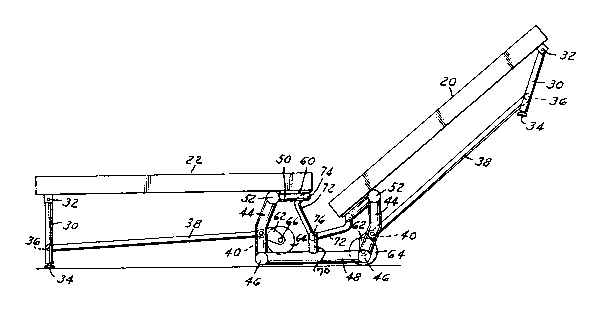Some of the information on this Web page has been provided by external sources. The Government of Canada is not responsible for the accuracy, reliability or currency of the information supplied by external sources. Users wishing to rely upon this information should consult directly with the source of the information. Content provided by external sources is not subject to official languages, privacy and accessibility requirements.
Any discrepancies in the text and image of the Claims and Abstract are due to differing posting times. Text of the Claims and Abstract are posted:
| (12) Patent: | (11) CA 1303640 |
|---|---|
| (21) Application Number: | 1303640 |
| (54) English Title: | FOLD AND ROLL STAGING |
| (54) French Title: | SCENE REPLIABLE MOBILE SUR ROULETTES |
| Status: | Expired and beyond the Period of Reversal |
| (51) International Patent Classification (IPC): |
|
|---|---|
| (72) Inventors : |
|
| (73) Owners : |
|
| (71) Applicants : |
|
| (74) Agent: | MARKS & CLERK |
| (74) Associate agent: | |
| (45) Issued: | 1992-06-16 |
| (22) Filed Date: | 1988-07-06 |
| Availability of licence: | N/A |
| Dedicated to the Public: | N/A |
| (25) Language of filing: | English |
| Patent Cooperation Treaty (PCT): | No |
|---|
| (30) Application Priority Data: | ||||||
|---|---|---|---|---|---|---|
|
ABSTRACT OF THE DISCLOSURE
A portable and foldable platform stage assembly has
two support panels movable from a collapsed position with panels
closely adjacent each other to an operative position with the
panels in a single plane, the inner edges in substantial contact.
Roller wheels move from a storage position when the panels are
in operative position to a floor contacting position when the
panels are collapsed for storage or movement. Outer legs move
from a storage position to a vertical operative position when
the panels are shifted to operative position. A central support
frame pivotally supports the inner edges of the platform panels
in the two positions with shaped spaced support links which
provide positive support in the operative position and adapt to
a receiving position when the panels are moved to storage
positions.
Note: Claims are shown in the official language in which they were submitted.
Note: Descriptions are shown in the official language in which they were submitted.

2024-08-01:As part of the Next Generation Patents (NGP) transition, the Canadian Patents Database (CPD) now contains a more detailed Event History, which replicates the Event Log of our new back-office solution.
Please note that "Inactive:" events refers to events no longer in use in our new back-office solution.
For a clearer understanding of the status of the application/patent presented on this page, the site Disclaimer , as well as the definitions for Patent , Event History , Maintenance Fee and Payment History should be consulted.
| Description | Date |
|---|---|
| Time Limit for Reversal Expired | 2008-06-16 |
| Letter Sent | 2007-06-18 |
| Inactive: IPC from MCD | 2006-03-11 |
| Inactive: IPC from MCD | 2006-03-11 |
| Grant by Issuance | 1992-06-16 |
There is no abandonment history.
| Fee Type | Anniversary Year | Due Date | Paid Date |
|---|---|---|---|
| MF (category 1, 5th anniv.) - standard | 1997-06-16 | 1997-05-29 | |
| MF (category 1, 6th anniv.) - standard | 1998-06-16 | 1998-05-28 | |
| MF (category 1, 7th anniv.) - standard | 1999-06-16 | 1999-06-03 | |
| MF (category 1, 8th anniv.) - standard | 2000-06-16 | 2000-06-02 | |
| MF (category 1, 9th anniv.) - standard | 2001-06-18 | 2001-06-04 | |
| MF (category 1, 10th anniv.) - standard | 2002-06-17 | 2002-05-31 | |
| MF (category 1, 11th anniv.) - standard | 2003-06-16 | 2003-06-03 | |
| MF (category 1, 12th anniv.) - standard | 2004-06-16 | 2004-06-03 | |
| MF (category 1, 13th anniv.) - standard | 2005-06-16 | 2005-06-03 | |
| MF (category 1, 14th anniv.) - standard | 2006-06-16 | 2006-05-30 |
Note: Records showing the ownership history in alphabetical order.
| Current Owners on Record |
|---|
| STAGERIGHT CORPORATION |
| Past Owners on Record |
|---|
| KENNETH EDWARD STATEN |
| ORLEY DAVID ROGERS |